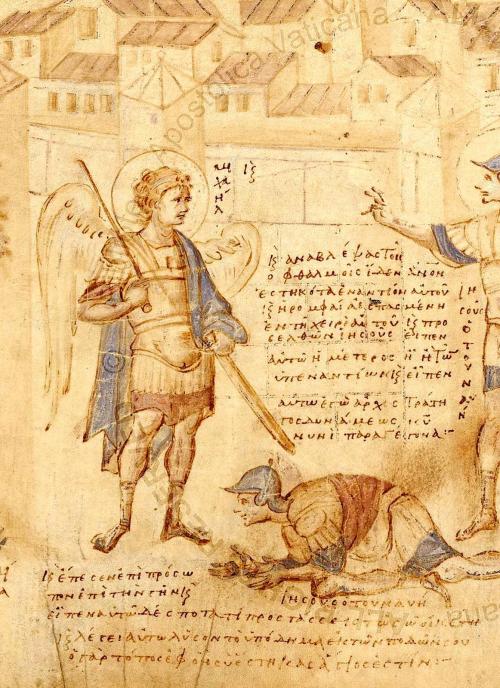#10th century
Archangel Michael appearing to Joshua. Byzantine illuminated manuscript, 10th century. Vatican Apostolic Library
Post link
“At the battle on the Danube in 971, beforeSviatoslav sued for peace, there came a black day of defeat for the Rus, when the Byzantine emperor’s cavalry drove the Rus warriors back against the walls of the town and many were “trodden underfoot by others in the narrow defile and slain by the Romans when they were trapped there.” As the victors were “robbing the corpses of their spoils,” wrote John Skylitzes in his Synopsis of Byzantine History a hundred years later, “they found women lying among the fallen, equipped like men; women who had fought against the Romans together with the men.”
The real valkyrie, The hidden history of viking warrior women, Nancy Marie Brown
“Estonian folklore revolves around women, and while its pagan culture was warlike, women were not excluded from that facet of life. In ancient Estonian burials, bodies were buried in communal tombs, marked by cairns, or coverings of stone. The bodies were allowed to rot before burial; then parts of skeletons of all ages and sexes were so intermingled that archaeologists cannot distinguish individuals, much less determine their gender.
(…)
Estonia’s communal burials held few or no grave goods, but in the middle of the tenth century—Hervor’s time—individual burials like those found throughout the Rus world became popular. Yet even in these individual graves, filled with weapons and jewelry and a skeleton capable of being sexed, gender remains irrelevant. Estonian women and men wore identical jewelry—unlike in neighboring lands, where men, though gaudily bedecked, had their own jewelry styles. Likewise, weapons are found in up to 30 percent of female graves in tenth-century Estonia, along with nongendered objects like tools, implying that women had equal access to power.”
The real valkyrie, The hidden history of viking warrior women, Nancy Marie Brown
“Kaupang’s women were buried as powerful landowners and as members of the chieftain’s retinue, some with weapons. Kaupang’s men were buried with cooking equipment and keys as often as women were; tools, horses and equestrian gear were also not gender-linked. And while Kaupang’s women were more often buried with weaving tools- and seem to have controlled a vast textile industry- these tools were found in men’s grave too.”
The real valkyrie, The hidden history of viking warrior women, Nancy Marie Brown
“But for all that, the man held the “dominant role in all walks of life”, I was taught. (…) He was the trader, the traveler, the warrior. His symbol was the sword.
The woman’s role, in turn, was symbolized by the keys she carried at her belt.
Except she didn’t.
(…)
These three are the only mentions of housewives with keys I can come up with: two women and a man in drag. They might reflect a pagan truth from before the year 1000. The might equally reflect the values of the medieval Christian world in which they were written. No one can say for sure.
Women with weapons appear in the same texts much more frequently than women with keys: I can name twenty warrior women from sagas and histories, another fifty-three in poems and myths. The earliest Icelandic law book (dated 1260 to 1280) considers women with weapons a threat to society - which implies they existed. You don’t write laws to control myths.”
The real valkyrie, The hidden history of viking warrior women, Nancy Marie Brown


Prince Mieszko I Introducing Christianity to Poland, A.D. 965(details)byRafał Hadziewicz (Polish, 1803-1886)

Medieval ducks
- Cathedral of Sorrento
- 10th-11th century
- Luni marble
- Museo Barracco, Rome
Rome, July 2015


